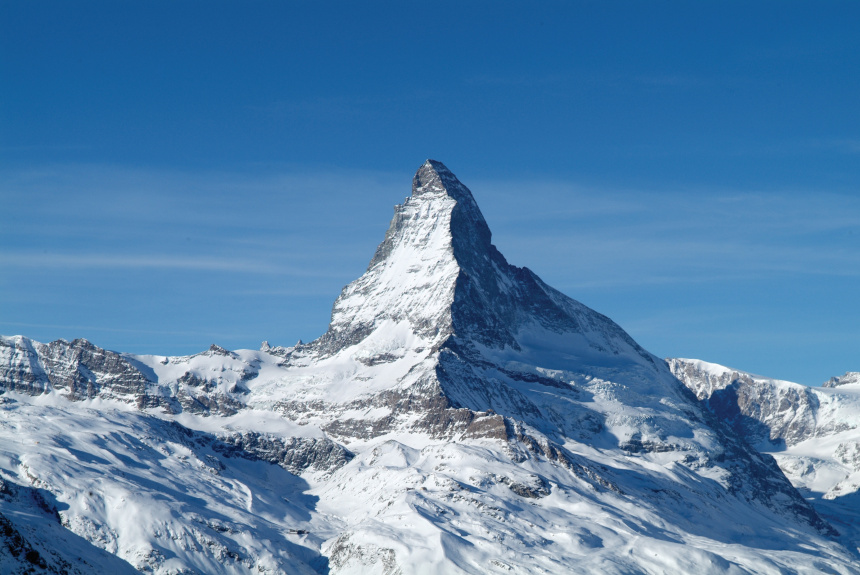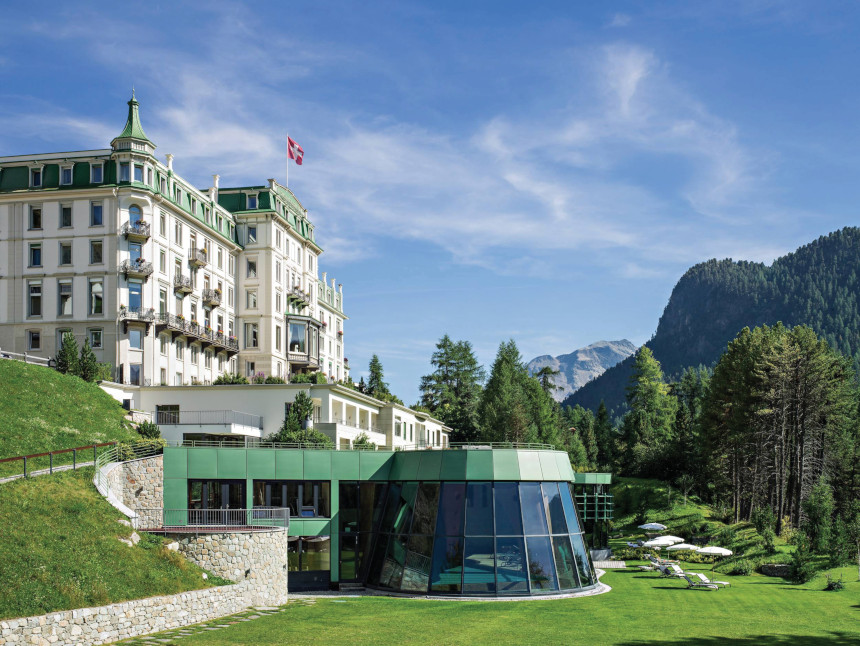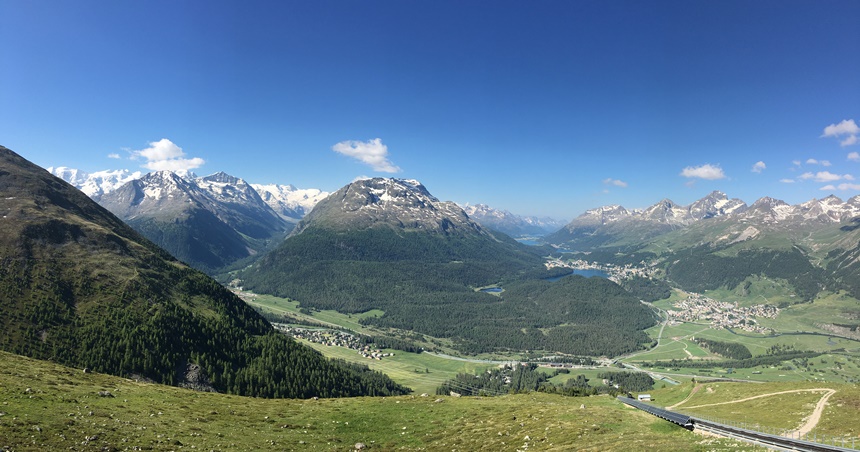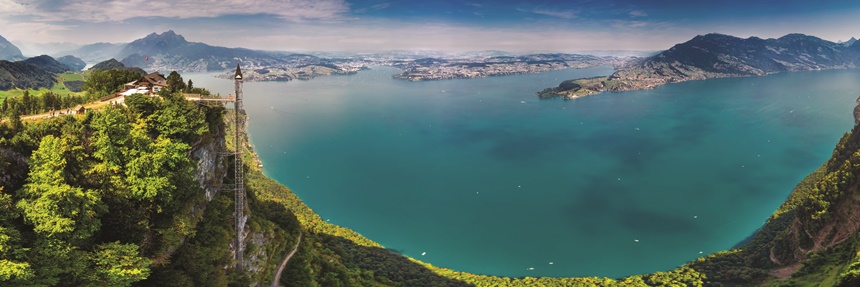The thing about Switzerland is, it’s just so darn pretty. The light is brighter, the leaves greener, the sky bluer. And in June the temperature is perfect. Not too hot; not too cold. And that mountain air, so crisp, so fresh.
And also, so neat. So… perfect. As if to prove that humans can remake the world as it should be, not as it naturally is.
The lawns are always mowed and weed-free, the roads absent of potholes, the houses freshly painted — and, wherever you go, something is missing: trash. In fact, a few days into the visit, my wife Estelle and I were walking on a winding path alongside perfectly tended flower beds by beautiful Lake Maggiore in Locarno. The lake water is clear (you can see to the bottom), the flowers are in full bloom, but what is this? A paper bag has wafted over in the breeze and landed on the path before us. Almost before it touches the ground, a local burgher, out for a morning walk, stoops down to pick up the offending article, depositing it in a bin nearby.
Let me just repeat that for emphasis: He picked up someone else’s garbage. Not as part of an official cleanup. No, this was a private citizen doing his civic duty.
Can a place be too pristine? Too perfect? Too precise? Not for the Swiss, apparently.
Now, I’m sure you’ve heard about the famous Swiss train system. I rode a lot of trains in the eight days I spent there. In each case, they left precisely on time. Not a minute early or late. More impressive was the fact that the trains also arrived precisely on time.
It’s not just the trains. My impression of the Swiss as a people is that precision has been baked into the DNA. Several times I had the experience of leaving my hotel room at the designated time for a meeting in the lobby — which is to say that I’d actually be arriving two or three minutes late. But, just as I was reaching for the doorknob, the phone would ring and the concierge would be on the line asking if I actually understood that I (foolish American) had a meeting scheduled.

TICINO
First stop, the Ticino region, the southern portion of Switzerland, bordering Italy. The local language is Italian, as is the feel of the region and the cuisine. To some degree, Ticino defies the stereotype of Switzerland. It’s not about green rolling meadows and bars of chocolate. (We’ll see that side of Switzerland in Lucerne later in the week.) There are even a few palm trees and cactus gardens.
We arrive in Locarno, just a few hours by train from the Zurich airport, and we set up quarters at the very comfortable three-star Hotel City Locarno, just a block from the shores of Lake Maggiore, the fourth-largest lake in Switzerland. Once settled, we tour the town’s large central piazza, which is lined with restaurants, pizza joints, and coffee bars and has the look and feel of many Northern Italian cities.
Up a steep street, we visit the church of Santa Maria Assunta (1636). The church has a wonderful origin story: In the early 17th century, a wealthy man from Locarno fell in love with a much younger woman. When her parents found out, they whisked her into a convent. The man went to Rome and appealed to the pope to free her so they could marry. The pope said sure, but you must first build me a church. So he began construction but, sadly, did not live to see it completed. With her suitor no longer an obstacle to freedom, the young woman could have returned home. But by then, she was accustomed to the peaceful ways and quiet days of the convent and spent the rest of her days there. Meanwhile, nice church!
Just over a bridge from Locarno is its sister city of Ascona, featuring a lively waterfront on the Piazza Giusseppe Motta, lined with restaurants and bars. A pair of buskers outfitted with an upright bass and flute are playing American jazz, which seems odd until you are reminded that there’s a big American jazz festival here every year in June. A semi-weekly farmer’s market features some things one would expect (zucchini) and, to our surprise, rice. The Ticino region, we learn, is the northernmost part of Europe where rice is grown.

The next morning, gray skies and a light rain. Despite the mist, we decide to go up the mountain above the town. On a clear day, there are spectacular views of the lake and the surrounding peaks. Today, with the weather, we don’t expect much. But we figure, what the heck? It’ll be a fun ride up, and it might be cool to be tucked into the clouds.
There are three stages to the ascent. A blue funicular leaves from the center of town. From there, one takes a cable car and then finally a chairlift to the summit. As we reach Cardada, the top of the cable car station, suddenly the clouds open up to reveal the whole vista.
Before taking the chair to the very top, we stop at the bistro at Cardada for a bite at a table overlooking the lake below. It’s 1:30, but this is Switzerland, not Italy, and we’ve missed lunch. “Dinner is over. Drinks only,” the waiter says. Must be the German influence. (We’d learned earlier that the German tourists eat supper at 6:30, like Americans, and similarly take their lunch in the noon hour.) No problem. We’re able to score a bag of potato chips and a Snickers bar, and that, plus the view, is completely satisfying.
Chairlift up to the top: Below us, a bull and small herd of cows munch placidly away, their bells tinkling in the crisp air, mingling with birdsong. Our ears pop. A short walk to the summit takes us to a flat platform with snow-capped peaks in every direction, poking through little puffs of clouds in the clearing sky. Below, Lake Maggiore extends all the way into Italy. A ferry is slowly making its way up from the Italian town of Stresa.
The next morning we’re up early to catch the Centovalli (literally “one hundred valleys”) train that cuts back and forth across the Italian border, rolling slowly through sharp turns alongside deep gorges. Two easy transfers later and we’re in Zermatt by lunchtime.
ZERMATT
I was eager to visit Zermatt because my grandmother brought me here in the late ’60s, when I was a teenager, and I remember being stunned by the spectacle of the Matterhorn. And here it is again, soaring up in the cloudless sky — still one of the most amazing sights.
Ana-Lisa, a young intern with Swiss tourism, meets us at the train. A hotel van picks up our bags, and we saunter off through the pedestrians-only town.
Zermatt’s renown as a tourist destination has its roots in an 1865 attempt by four British climbers to summit the Matterhorn. Along with a French guide and two Zermatt locals, they got to the peak, but a slip on the way down resulted in the death of four of the adventurers, leaving only Englishman Edward Whymper and the two Zermatt porters, Peter Taugwalder and his son Peter Jr., alive. After the accident, a much-alarmed Queen Victoria considered forbidding British citizens from mountain climbing and other dangerous exploits abroad. The queen’s consternation was widely disregarded and incidentally made Zermatt famous. By 1891, a train line was completed and several grand hotels were built. Twenty years later, when cars became common, the decision (a wise one) was made not to widen the streets and effectively destroy this 500-year-old alpine village. Today, it still remains closed to cars, so it’s absent the noise and bustle of modern towns. The few service vehicles that operate here — garbage trucks, delivery wagons — are required to be electric-powered.

Switzerland has four official languages, French, Italian, German, and Romansh. German is the predominant language, used by over 60 percent of the population. But there are somewhere in the neighborhood of two dozen dialects of German spoken across the population. The language has evolved over the centuries in the many little pockets of the mountainous country where travel, until modern times, was difficult. Not just intonation, but whole words changed. To this day, many German-speaking Swiss grow up learning their own regional dialect and may barely understand the speech of their neighbors from the next valley over. To communicate, most also learn proper (or high) German in school. English is also commonly understood and spoken.
Switzerland is a wealthy country with full employment. By age 15, children are divided into either trade or academic tracks. Students on the trade track immediately begin apprenticeships that lead to good jobs at good wages. The academic track continues on to university.
Not surprisingly, such a wealthy country is also expensive. (On the Big Mac index, the Economist’s light-hearted comparison of the cost of living in different countries based on the relative price of McDonald’s most popular offering, Switzerland ranks number one. Its Big Mac is 18 percent more expensive than in the U.S.) The country does have offerings for budget travelers — three-star hotels are in the same price range as a Hilton, say, in the U.S.
Back in our hotel that evening, I sit on the deck watching the sun set behind the Matterhorn. Half a dozen kite-gliders float lazily down on the breezes, their bright avian plumage a stark contrast to the darkening sky.

The next morning we hop on the Gornergrat train, a popular tourist attraction first opened in 1898 that takes us up sharply from the center of town to a viewing station at 10,135 feet with stunning views of the Matterhorn and 29 other mountain peaks.
At the restaurant adjoining the viewing area, we dine on cured meats and cheese followed by braised veal and washed down with a bottle of wine. On the way down, we exit the train one stop before it reaches Zermatt and take a zig-zagging downhill hike the rest of the way, futilely attempting to burn off some of the calories from lunch.
PONTRESINA
Early the next morning, we climb aboard the Glacier Express for the sleepy village that lies across the valley from the glitter of St. Moritz. The train is outfitted with huge picture windows that give passengers almost a 360-degree view of mountains and forests as it runs smoothly past small villages and the slate-colored rivers that pour down from the glaciers. First-class tickets on the train include a luxurious three-course meal, served with linen napkins and wine.
We stay at the five-star Grand Hotel Kronenhof, originally a modest guesthouse that was purchased in 1848 by the Gredig family and extensively renovated a few years later. The courtyard at the entrance evokes bygone days when elegant occupants piled out of horse-drawn carriages for their vacations in the mountain air. These days, a stretch BMW whisks you from the nearby train station to the door. Inside, impeccable flower arrangements adorn the lobby. The elegant and spacious rooms — dark wood and marble throughout — have high ceilings and a balcony. The hotel has a swimming pool, bowling alley, and three restaurants. The spa features an infinity pool that looks out on the Alps through picture windows. There’s also a complicated hot tub, large enough to accommodate a dozen bathers, each with their own little pod in which to be privately assaulted by bubbles before a massage. One could spend a month here, and many families do, returning year after year.
On a tour of the hotel, we enter a doorway marked “Gredig stübli” (the original Gredig family’s private living room). Inside a small, dark room, a secret window gives out on a view of the hotel courtyard. We learn that in the early days, the owner or his agent would keep watch from here as guests pulled up in their carriages. If the carriage was well appointed and carrying nicely dressed guests with lots of luggage, a message would go to the front desk, and prices would rise accordingly. An early example of surge pricing?

The next day, I meet mountain guide Christine for a tour of the town and a hike. We travel to nearby Punt Muragl and take the red funicular up to Muottas Muragl, an observation station overlooking the 100-kilometer Engadine Valley. In the distance, Lake St. Moritz glitters, framed by snowy peaks. After applying sunblock, we head out on the aptly named Panorama trail for a mostly lateral, 5-kilometer hike to Alp Languard, another observation station that sits directly above Pontresina and is served by a chairlift.
It’s not a difficult hike, but the trail is narrow, and in places, the cliff drops away just inches from the gravel path. We pass alpine meadows blanketed with daisies, buttercups, blue forget-me-nots, purple orchids, the fly-catching butterwort, and a yellow flower called cypress spurge. Around a turn, the whole mountainside is awash in scarlet mountain rose.
We enter a piney area, and I learn to identify larch pines, arrow pines, and alpine pines. Christine tells me about the nutcracker bird, whose unintentional mission is to propagate pine trees by planting pine nuts in the ground for safekeeping. So good is the bird’s internal GPS that it will generally retrieve 80 percent of the nuts, but the remaining ones take root.

Aside from German, locals here also speak the ancient language of Romansh, a direct descendant of the spoken Latin of the Roman Empire. In a 2012 survey, more than 35,000 residents of this southeastern region of Switzerland described Romansh as their primary language. Christine is fluent and offers fellow hikers the Romansh greeting “Allegra” as we pass.
We reach the viewing station Alp Languard, where we dine on charcuterie and a light salad, joined by Christine’s mountaineer husband, who has climbed directly up from Pontresina, eschewing the chairlift. Christine tells me that another 3 kilometers up the mountain is a hut catering to hikers that, until this year, was managed by a local woman known for her delicious nutcakes.
Time’s passage in the Alps is measured in incremental changes, but it seems these are occurring more noticeably now. Next year, the nutcake woman is retiring and a local man is taking over the concession, which is too bad, says Christine, since “nobody makes a cake like hers.” She says this not exactly with sadness, but rather with resignation about the slow, inevitable decline of all things — the disappearance of the nutcake, the deterioration of a mountaineer’s knees, and the melting of the permafrost which she had earlier pointed out as teardrop-shaped gashes in the higher reaches of the mountain.
LUCERNE
A fast ferry that docks right across a plaza from the train station shuttles us across Lake Lucerne in about 20 minutes to Bürgenstock Hotel, a five-star, 102-room jewel box resting on a hilltop 1,600 feet above the lake. The 150-acre resort also encompasses the more classical architecture of the Palace Hotel and a health and wellness destination, the Waldhotel. Spread across the campus are multiple restaurants, lounges, and bars, ranging in theme from Middle Eastern to Asian to haute cuisine, plus a nine-hole golf course, indoor and outdoor tennis courts, and hiking and biking trails.

Built in the 1870s, the hotel became a playground for celebrities through the 20th century — a photo of Audrey Hepburn in golf attire adorns the entrance to the fitness facility. In recent years, a Qatari investment group spent upward of $500 million to renovate the facility.
A funicular built in 1888 zips us from the ferry dock to the hotel, where we check into our futuristic room featuring bay windows with stunning views of Lake Lucerne, a double-sided fireplace, a deep soaking tub, and wood and stone details throughout.
Later in the afternoon, I hike the appropriately named Cliff Walk to the Hammetschwand elevator, built at the turn of the last century, which, in a stomach-lurching, 60-second trip, hurtles you to a lookout platform at the top of Mount Bürgenstock. There, to soothe tourists after the shock of the ride, there are picture-postcard views of the lake below, Lucerne beyond, and, in the other direction, green valleys and snow-capped mountains.
Avoiding the elevator ride, I follow a path that zig-zags down the back side of the mountain, at one point coming smack dab into a small herd of cows and a bull that eyes me suspiciously as I edge cautiously past. Estelle meanwhile has been at the hotel enjoying the infinity pool that extends out over the cliff.
It’s almost too pretty and luxurious to believe, and I find myself remembering what some of our Italian friends had said about Switzerland — that it is too neat, too clean, and that they found the Swiss perfectionism annoying.
I must disagree. With all the chaos in the world — the ugliness, the meanness, the anger — I welcome a place that is neat and clean, where people pick up the trash voluntarily, and where they are kind and welcoming. The eternal beauty of Switzerland has inspired writers, artists, and travelers for thousands of years. And I’m happy today’s diligent Swiss citizens are committed to keeping it that way for thousands more.
Steven Slon is the Post‘s editorial director.
Featured image: Shutterstock
Become a Saturday Evening Post member and enjoy unlimited access. Subscribe now




Comments
The beautiful pictures on this article, makes one be there! We have been there, but did we not see all of it!